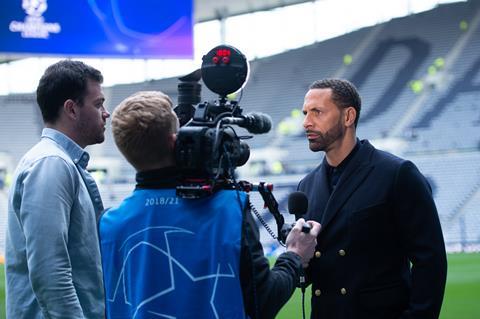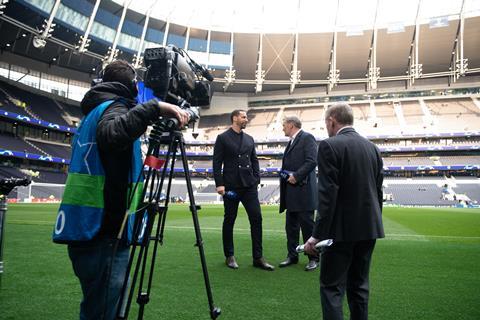BT Sport COO Jamie Hindhaugh outlines how the broadcaster’s Champions League final coverage will be the first time a live sports event will be broadcast in HDR to mobile devices.

The all-English clash in the UEFA Champions League Final will make a winner out of BT Sport which aims to prize maximum publicity out of expected massive domestic interest in the game between Liverpool and Tottenham Hotspur.
For a start, BT will ensure its coverage can be watched by anyone by broadcasting it for free on YouTube.
“The aim is to make this the most connected Champions League Final ever,” asserts Jamie Hindhaugh, chief operating officer, BT Sport.
The event on June 1 will also act as a showcase for BT Sport’s High Dynamic Range (HDR) offering as it lays claim to the title of the UK’s most innovative broadcaster. The company says that this will marks the first time that a live sports event will ever be broadcast in HDR to mobile devices.
“The aim is to make this the most connected Champions League Final ever”
Mediapro is broadcasting UEFA’s world feed, but it will not feature HDR, so BT Sport has taken upon itself the task of producing separate HDR-specific coverage.
In fact, it will produce three entirely separate versions of the live match from three OB trucks at the Wanda Metropolitano stadium in Madrid – home of Spanish football’s Atlético Madrid.
Aside from a version of the host feed, which will be augmented by BT’s unilateral cameras and presentation, it will produce a different BT-specific HDR version and another bespoke one in 360 VR.
The world feed is produced in 4K UHD with Dolby Atmos for distribution in the UK on BT Sport channels (also through Virgin), and without Atmos, on BT Sport’s YouTube channel and on BT Sport’s website.

Main match coverage will follow the template laid out in previous Champions League finals consisting of approximately 50 cameras into which BT will insert replays for its own presentation.
Gary Lineker leads studio punditry with talent including Rio Ferdinand. Additional BT crews will be at fan parks in Tottenham and Liverpool for pre-match, halftime and post-match reaction.
The HDR feed is being produced out of a Telegenic truck and made available to BT Sport’s 5 million+ subscribers through the BT Sport app, and via mobile devices, taking advantage of the HDR displays on most new handsets as well as on devices including Xbox One, Samsung Smart TV and Apple TV.
It’s a curtain raiser to an HDR mobile service launching for the start of the next football season in which up to 70 events will be produced live in HDR a year.
“The HDR feed will be the only place to see the whole of the opening ceremony,” Hindhaugh says. “With HDR you see the real pitch colour, detail and colour in the shirts and you’re much more immersed in the game.”
“With HDR you see the real pitch colour, detail and colour in the shirts and you’re much more immersed in the game.”
He explains: “When we’ve done HDR trials previously we’ve done so as a single workflow. Because of the nature of the event in which we’re not the host we are doing a separate coverage from 20 camera positions. The key is to make sure the World Feed stays clean.”
There are four broadcast cameras behind each goal for example: two for the host and two for BT Sport’s HDR output. There will be a bespoke commentary.
“We need to replicate the normal camera plan as far as possible. It needs to be a compelling watch. This is no experiment,” adds Hindhaugh.
“With our expertise in HDR we think we are further ahead of the game than most other broadcasters. Even when we’ve output SDR feeds recently we’ve been down-converting those from HDR.”
The format is HDR10 PQ since alternative format HLG works less well on mobile – and mobile is the telco’s primary target for the HDR service, particularly given the launch on 30 May of 5G networks in six UK cities on 30 May by BT-owned mobile operator EE.
The HDR is being output in HD, even though 4K resolution is possible. “To be frank if we’re looking at mobile first then data usage for 4K is prohibitive whereas with HD HDR it is minimal. Also, when you consider the size of the mobile screen then adding 4K adds nothing [in terms of perceptual image quality]. Most of our perception of depth comes from contrast, not resolution.”
While its strategy for mobile is HD HDR, users will also be able to get 4K HDR when the proposition launches.
- Read more: Monitoring 4K/HDR content
“Depending on what device and connectivity you have you will get different flavours of the same event.”
A third BT truck is dedicated to 360-VR. This will be captured in 4K (output as HD), unlike a trial during the FA Cup Final earlier this month which was produced in 8K.
The VR from Madrid will be captured from 12 multi-camera rigs, stitched live and directed with separate commentary from Spencer Owen. BT has been producing 360-degree highlights for major events for some time and plans to continue that going forward but for this Champions League Final is will live stream the entire match in virtual reality.
“We can offer different angles to that which you would normally get,” explains Hindhaugh.
“Ultimately where we want to migrate to is to capture VR in 8K and offer users the chance to ‘pinch and zoom’ into the picture on their phones,” he says. “The image quality at 8K is so much better for this interactive experience.”
The 8K test at Wembley used two rig positions and Blackmagic Design Micro Studio cameras. Pictures were rendered using Tiledmedia’s encoding software and switched using the BMD ATEM Constellation 8K.
Hindhaugh says: “I’ve always believes that people will gravitate to watch events like this on the biggest screen available, but we are also about giving different viewing experiences all of which will take fans close to the heart of the live sport.”

BT Sport debuted as Europe’s first 4K broadcaster in 2016, produced the first 4K UHD host broadcast of a Champions League Final in 2017 from Cardiff, and made a worldwide debut of Dolby Atmos broadcast sound in 2017.
“What we are doing in Madrid, we did at Cardiff only in much more trial form,” he says. “It’s easier when you’re in control of the end to end chain and when you are not it creates a bigger challenge. This final is also not on our doorstep, so the logistics are more challenging but one we are comfortable with.”
A few years ago, when Sky was the only horse in town, it was pursuing stereo 3D as the height of the live sport viewing experience. Hindhaugh doesn’t think it will make a comeback.
“I’ve always said we’ll never do it. When you see HDR in purist quality with 4K then it looks three dimensional. I don’t think 3D works for live sport since sport is a social event you want to watch with friends, not behind goggles.”
“3D doesn’t work for live sport – it is a social event you want to watch with friends, not behind goggles”
Hindhaugh was speaking to IBC365 from Madrid having just flown in from Baku where he oversaw BT Sport’s coverage of the other all-English final - the UEFA Europa League. He acknowledged that the atmosphere before and during the game suffered from the game being held in a location many fans could not get to.
He adds: “Baku went as well as it could when you have a stadium that size and the pitch is a long way from the seats. We can only work with the stadium we are in and the audience who are there, but our team covered it well.”
There will be no such doubts ahead of Saturday’s match which will see England dominate Europe for a short while at least.
- Watch webinar on-demand: Crafting quality: Skills for successful UHD and HDR production



























No comments yet